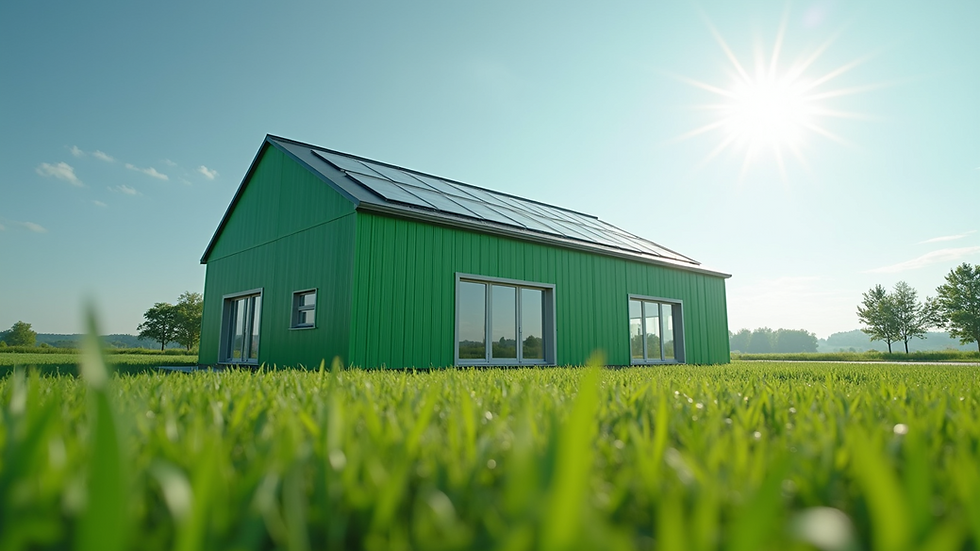Transformative Architectural Design for Modern Needs
- Anuja Shinde
- 5 days ago
- 4 min read
In today's fast-paced world, architectural design plays a crucial role in shaping our environments. As we navigate through urban landscapes, the need for innovative and functional spaces has never been more pressing. Transformative architectural design not only meets the demands of modern living but also enhances our quality of life.
This blog post explores how contemporary architecture adapts to our evolving needs, focusing on sustainability, flexibility, and community engagement. We will look at specific examples that illustrate these principles in action.
The Importance of Sustainability in Architecture
Sustainability is at the forefront of modern architectural design. As climate change becomes a more pressing issue, architects are finding ways to create buildings that are not only beautiful but also environmentally friendly.
Green Building Materials
Using sustainable materials is one way architects are making a difference. For instance, bamboo is a popular choice due to its rapid growth and strength. Recycled steel and reclaimed wood are also gaining traction. These materials reduce waste and lower the carbon footprint of new constructions.
Energy Efficiency
Energy-efficient designs are another key aspect of sustainable architecture. Buildings equipped with solar panels, green roofs, and energy-efficient windows can significantly reduce energy consumption. For example, the Bullitt Center in Seattle is known as the greenest commercial building in the world. It generates more energy than it consumes, showcasing the potential of sustainable design.
Flexibility in Design
Modern life is dynamic, and our spaces should reflect that. Flexible architectural designs allow for adaptability, catering to various needs over time.
Multi-Functional Spaces
Creating multi-functional spaces is a growing trend. For instance, a room that serves as a home office during the day can transform into a cozy living area at night. This approach maximizes the use of space, especially in urban environments where square footage is often limited.
Modular Design
Modular design is another innovative solution. Buildings can be constructed using pre-fabricated modules that can be easily assembled and reconfigured. This method not only speeds up construction but also allows for future expansions or modifications. A great example is the M.A.DI. House, an Italian modular home that can be assembled in just a few days.
Community Engagement in Architecture
Architecture is not just about buildings; it is also about the people who inhabit them. Engaging the community in the design process leads to spaces that truly reflect the needs and desires of their users.
Participatory Design
Participatory design involves stakeholders in the planning process. This approach ensures that the final design meets the community's needs. For example, the design of the High Line in New York City was influenced by local residents. Their input helped transform an old railway into a vibrant public park, enhancing the neighborhood's appeal.
Public Spaces
Creating inviting public spaces is essential for fostering community interaction. Parks, plazas, and community centers encourage socialization and collaboration. The Millennium Park in Chicago is a prime example, offering a space for art, music, and recreation, all while enhancing the urban landscape.
The Role of Technology in Modern Architecture
Technology is revolutionizing the way we design and build. From advanced software to smart home systems, technology is making architecture more efficient and user-friendly.
Building Information Modeling (BIM)
BIM is a game-changer in architectural design. It allows architects to create detailed 3D models of buildings, making it easier to visualize and modify designs. This technology reduces errors and improves collaboration among project teams.
Smart Homes
Smart home technology is becoming increasingly popular. Features like automated lighting, heating, and security systems enhance convenience and energy efficiency. For instance, homes equipped with smart thermostats can learn the occupants' habits and adjust temperatures accordingly, leading to energy savings.
Case Studies of Transformative Architectural Design
To illustrate the principles discussed, let’s look at a few notable examples of transformative architectural design.
The Edge, Amsterdam
The Edge is often referred to as the greenest office building in the world. It features a unique design that maximizes natural light and incorporates sustainable materials. The building also includes smart technology that allows employees to control their work environment, promoting comfort and productivity.
Bosco Verticale, Milan
Bosco Verticale, or Vertical Forest, consists of two residential towers covered in trees and plants. This innovative design not only provides stunning views but also improves air quality and biodiversity in the urban environment. The project demonstrates how architecture can harmonize with nature.
The Spheres, Seattle
The Spheres at Amazon's headquarters are a striking example of biophilic design. These glass structures house a variety of plants and trees, creating a unique indoor ecosystem. The Spheres serve as a space for employees to relax and connect with nature, promoting well-being in the workplace.
The Future of Architectural Design
As we look ahead, the future of architectural design will likely focus on even greater sustainability, flexibility, and community engagement.
Innovations on the Horizon
Emerging technologies such as 3D printing and artificial intelligence are set to transform the industry. 3D printing can reduce waste and lower costs, while AI can assist in creating more efficient designs.
A Focus on Well-Being
The emphasis on well-being will continue to grow. Architects will increasingly consider how spaces affect mental and physical health. Designs that incorporate natural light, green spaces, and community areas will become more prevalent.
Embracing Change in Architecture
Architectural design is evolving to meet the needs of modern society. By prioritizing sustainability, flexibility, and community engagement, architects are creating spaces that enhance our lives.
As we embrace these changes, we can look forward to a future where our built environments are not only functional but also enriching. The transformative power of architecture can lead to healthier, happier communities.

In conclusion, the journey of architectural design is one of continuous evolution. By understanding and adapting to our needs, architects can create spaces that inspire and uplift. The future is bright for transformative architectural design, and we are all part of this exciting journey.

Commentaires